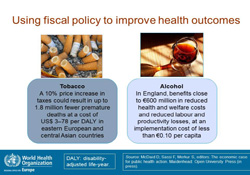The economics of tobacco

WHO
Tobacco use is one of the leading preventable causes of death, killing more than 7 million people every year. More than its enormous toll of disease, suffering and death, tobacco use also burdens the global economy each year with an estimated US$ 1.4 trillion in health-care costs, lost productivity, fire damage, environmental harm from cigarette litter and destructive farming practices.
Today, we have a greater understanding of how to reduce the economic and health costs of this deadly epidemic. While a combination of measures, such as those outlined in the WHO Framework Convention on Tobacco Control (WHO FCTC), are needed for effective tobacco control, increases in tobacco taxes are known to reduce tobacco consumption faster than any other single measure. For this reason, taxation is a crucial tool in the effort to attain a tobacco-free Europe. Article 6 of the WHO FCTC encourages price and tax measures as effective means to reduce the demand for tobacco, including increasing taxes to raise the sales price of tobacco products and prohibiting or restricting sales of tax- and duty-free tobacco products.
The WHO European Region leads the way globally in tobacco tax increases and has made great progress in recent years. The number of countries with tax shares representing more than 75% of the retail price of the most popular brand of cigarettes was 25 (47%) in 2016. However, according to the last WHO report on the global tobacco epidemic, increasing tobacco taxes has slowed down in the European Region in the last years. No improvement has been made since 2014 in total population coverage of this tobacco control measure. By raising the excise tax, policy-makers are able to raise the retail price of cigarettes, making the product less affordable. But if price increases do not keep pace with increases in per capita income and consumer purchasing power over time, tobacco products become more affordable.
The countries in the European Region with the highest prices are Belgium, France, Ireland, the Netherlands and the United Kingdom. Many examples can be found of successful implementation of the provisions of Article 6 of the WHO FCTC in the Region. For instance:
- In France, large price increases were followed by declines in smoking prevalence and lung cancer deaths.
- In Romania, the Russian Federation and Ukraine the annual excise increases led to a substantial rise in revenues (7, 11 and 12-fold increases respectively) and drops in cigarette sales (by 42%, 22%, and 40% respectively).
- Between 2005 and 2011, Turkey increased tobacco taxes sufficiently to raise the prices of tobacco by 195%. Meanwhile, revenues from tobacco taxes increased by 124%, while tobacco sales dropped by 16% over the same period.
- The United Kingdom has successfully raised taxes above the inflation level, increased the revenues from tobacco taxes despite consistent drops in smoking prevalence, and at the same time reduced illicit trade.
The tobacco industry continues to devote substantial resources and efforts to employing a range of tactics intended to interfere with the implementation of provisions of the WHO FCTC, including Article 6. In particular, they continue to promote misleading economic arguments, such as that increasing taxation on tobacco products will lead to increased illicit trade, a loss of jobs and lost revenues. The truth, however, is that tobacco control does not harm economies and the increased taxes create a win–win situation for public health and the economy, as revenues rise even as smoking rates fall, as we have seen, time and again, in the countries of the European Region.










